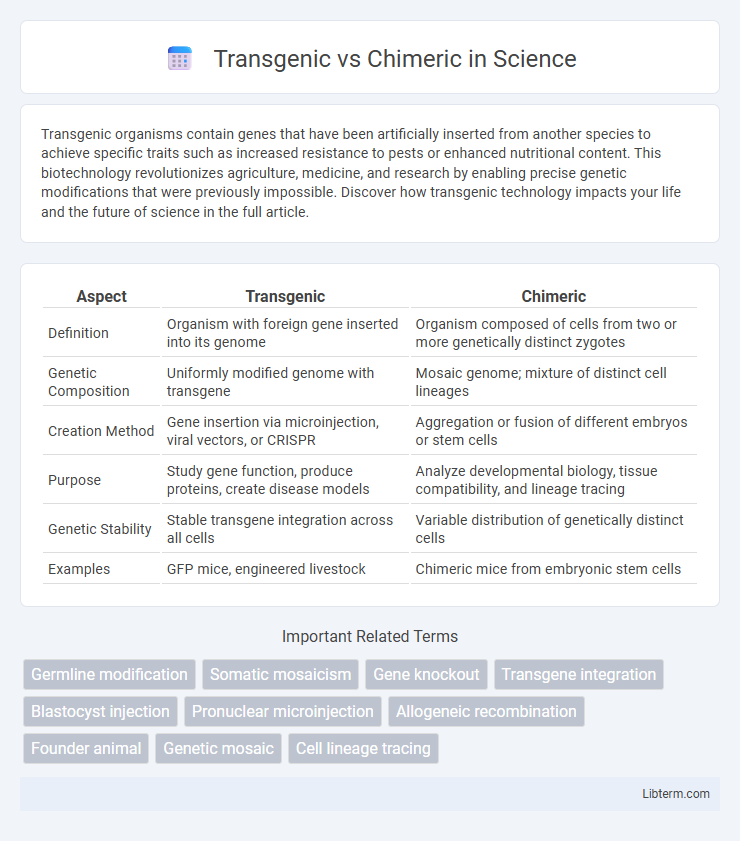Transgenic organisms contain genes that have been artificially inserted from another species to achieve specific traits such as increased resistance to pests or enhanced nutritional content. This biotechnology revolutionizes agriculture, medicine, and research by enabling precise genetic modifications that were previously impossible. Discover how transgenic technology impacts your life and the future of science in the full article.
Table of Comparison
| Aspect | Transgenic | Chimeric |
|---|---|---|
| Definition | Organism with foreign gene inserted into its genome | Organism composed of cells from two or more genetically distinct zygotes |
| Genetic Composition | Uniformly modified genome with transgene | Mosaic genome; mixture of distinct cell lineages |
| Creation Method | Gene insertion via microinjection, viral vectors, or CRISPR | Aggregation or fusion of different embryos or stem cells |
| Purpose | Study gene function, produce proteins, create disease models | Analyze developmental biology, tissue compatibility, and lineage tracing |
| Genetic Stability | Stable transgene integration across all cells | Variable distribution of genetically distinct cells |
| Examples | GFP mice, engineered livestock | Chimeric mice from embryonic stem cells |
Introduction to Transgenic and Chimeric Organisms
Transgenic organisms carry genes that have been artificially introduced from another species, enabling new traits through precise genetic modification techniques like gene cloning and microinjection. Chimeric organisms contain cells from two or more different zygotes, resulting in a single individual with genetically distinct cell populations, often produced through embryo aggregation or cell transplantation. Understanding these fundamental differences in genetic composition and creation methods is essential for advances in biotechnology, agriculture, and medical research.
Defining Transgenic Organisms
Transgenic organisms contain DNA sequences inserted from a different species through genetic engineering, enabling new traits or functions not naturally present. These organisms are created by introducing foreign genes into their genome, resulting in stable, heritable genetic modifications. Unlike chimeric organisms, transgenics possess a single, modified genome with integrated foreign DNA rather than a mixture of genetically distinct cells.
Understanding Chimeric Organisms
Chimeric organisms contain cells from two or more genetically distinct zygotes, resulting in an individual with multiple sets of DNA, unlike transgenic organisms that have foreign genes inserted into their genome. Understanding chimeric organisms is crucial in biomedical research for creating models that mimic complex human diseases and for organ transplantation studies. These organisms demonstrate unique genetic mosaicism, providing valuable insights into developmental biology and cellular differentiation.
Key Differences Between Transgenic and Chimeric Organisms
Transgenic organisms contain genes that have been artificially introduced from another species, resulting in stable genetic modification throughout their cells. Chimeric organisms consist of cells from two or more different zygotes, creating a composite organism with genetically distinct cell populations. The primary difference lies in the origin and distribution of the genetic material: transgenic organisms have a uniform genome modified via gene transfer, while chimeric organisms have a mosaic genome composed of separate cell lineages.
Genetic Modification Techniques: Transgenesis vs. Chimera Creation
Transgenic techniques involve the insertion of foreign genes into an organism's genome to create genetically modified organisms with specific traits, while chimera creation combines cells from different zygotes to produce an organism composed of genetically distinct cell populations. Transgenesis utilizes methods such as microinjection, viral vectors, and CRISPR-Cas9 to achieve targeted gene integration, whereas chimera creation requires the aggregation or injection of pluripotent stem cells or blastomeres at early developmental stages. These distinct genetic modification techniques enable diverse applications in developmental biology, disease modeling, and biotechnological innovations.
Applications in Research and Biotechnology
Transgenic animals are engineered by inserting foreign genes into their genome, enabling precise studies of gene function and disease models in biomedical research. Chimeric animals contain cells from two or more distinct zygotes, making them crucial for developmental biology studies and regenerative medicine through cell lineage tracing and tissue integration. Both technologies advance biotechnology applications, such as producing pharmaceuticals, improving livestock traits, and studying complex genetic interactions.
Ethical Considerations and Regulatory Concerns
Transgenic organisms involve the insertion of foreign genes into an organism's genome, raising ethical concerns about gene manipulation and potential impacts on biodiversity, while chimeric organisms contain cells from two or more different species, provoking debates about species boundaries and identity. Regulatory frameworks for transgenic animals focus on gene safety, environmental release, and food consumption, whereas chimeric research faces stricter scrutiny due to ethical dilemmas related to human-animal cell integration and potential consciousness issues. Both technologies require comprehensive risk assessments and adherence to guidelines established by agencies such as the FDA, EMA, and national bioethics committees to ensure responsible research and application.
Advantages and Limitations of Transgenic Methods
Transgenic methods enable precise insertion of foreign genes into an organism's genome, facilitating targeted studies on gene function and trait development, which significantly advances genetic engineering and biomedicine. However, these methods face limitations such as unpredictable gene expression due to position effects, potential disruption of endogenous genes, and ethical concerns related to genetic modification. Despite these challenges, transgenic techniques provide a powerful tool for creating genetically modified organisms with specific traits that can be passed to future generations.
Advantages and Limitations of Chimeric Approaches
Chimeric approaches offer advantages such as the ability to combine cells or tissues from different genotypes, enabling functional studies and therapeutic applications like organ transplantation or disease modeling. These techniques provide rapid generation of organisms with desired traits without the need for germline modification, which can be time-consuming and technically challenging. However, limitations include potential immune rejection, mosaicism, and ethical concerns related to the integration of foreign cells into host organisms, which may hinder clinical translation.
The Future of Transgenic and Chimeric Technologies
Transgenic technologies enable precise gene insertion to create organisms with enhanced traits, while chimeric technologies combine cells from multiple species to develop complex biological systems. Future advancements in transgenic methods promise breakthroughs in disease resistance, agricultural productivity, and gene therapy, leveraging CRISPR and advanced gene-editing tools. Chimeric innovations are expected to revolutionize regenerative medicine and organ transplantation by enabling the growth of hybrid organs tailored for human compatibility.
Transgenic Infographic

 libterm.com
libterm.com